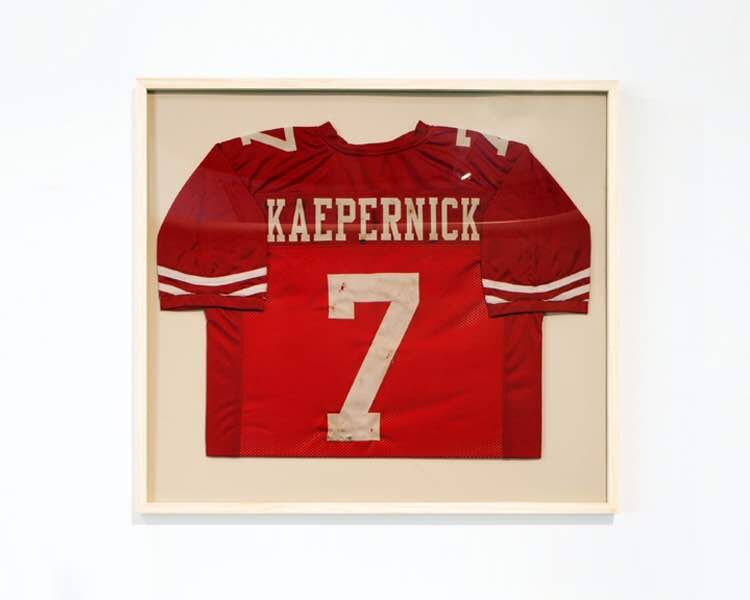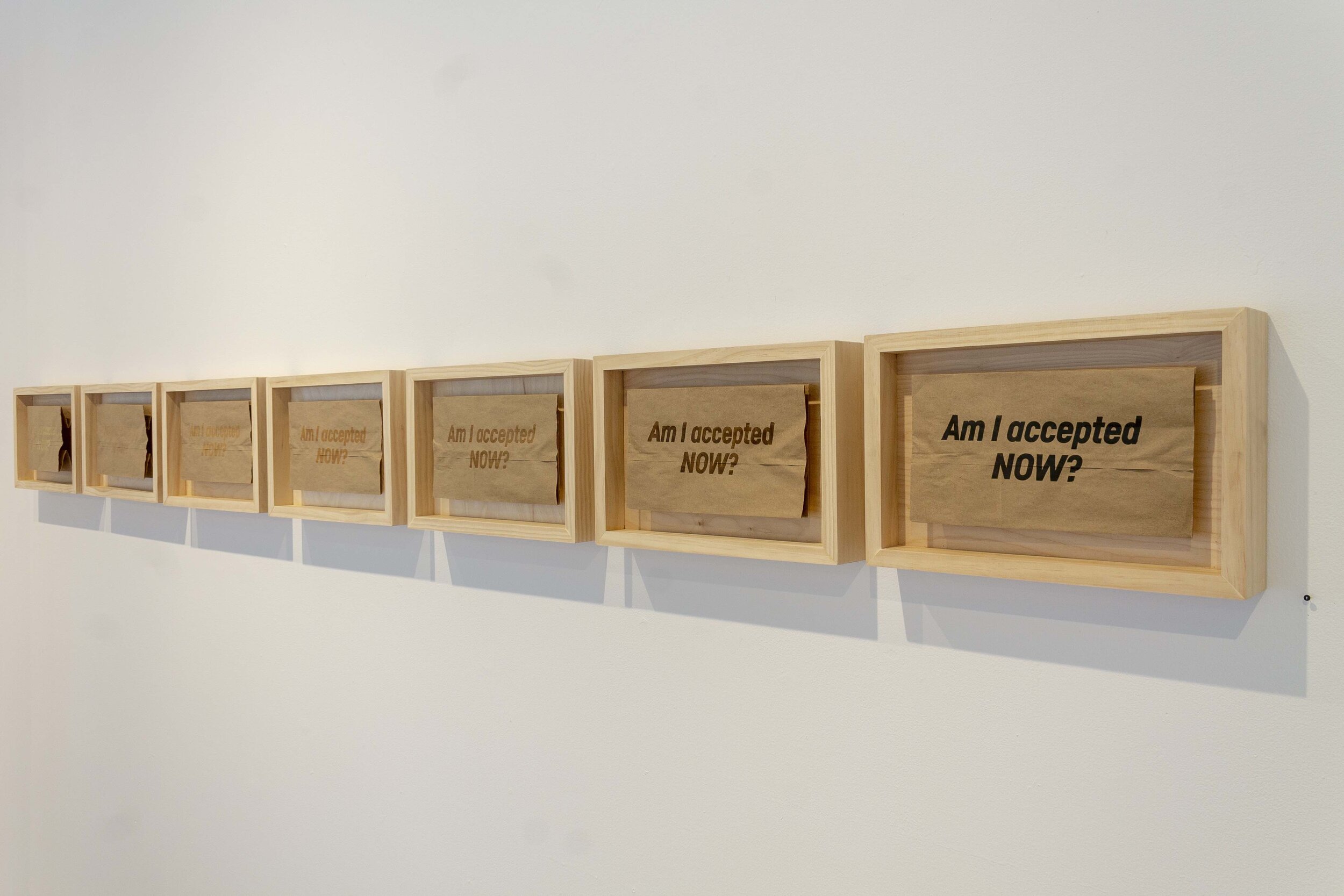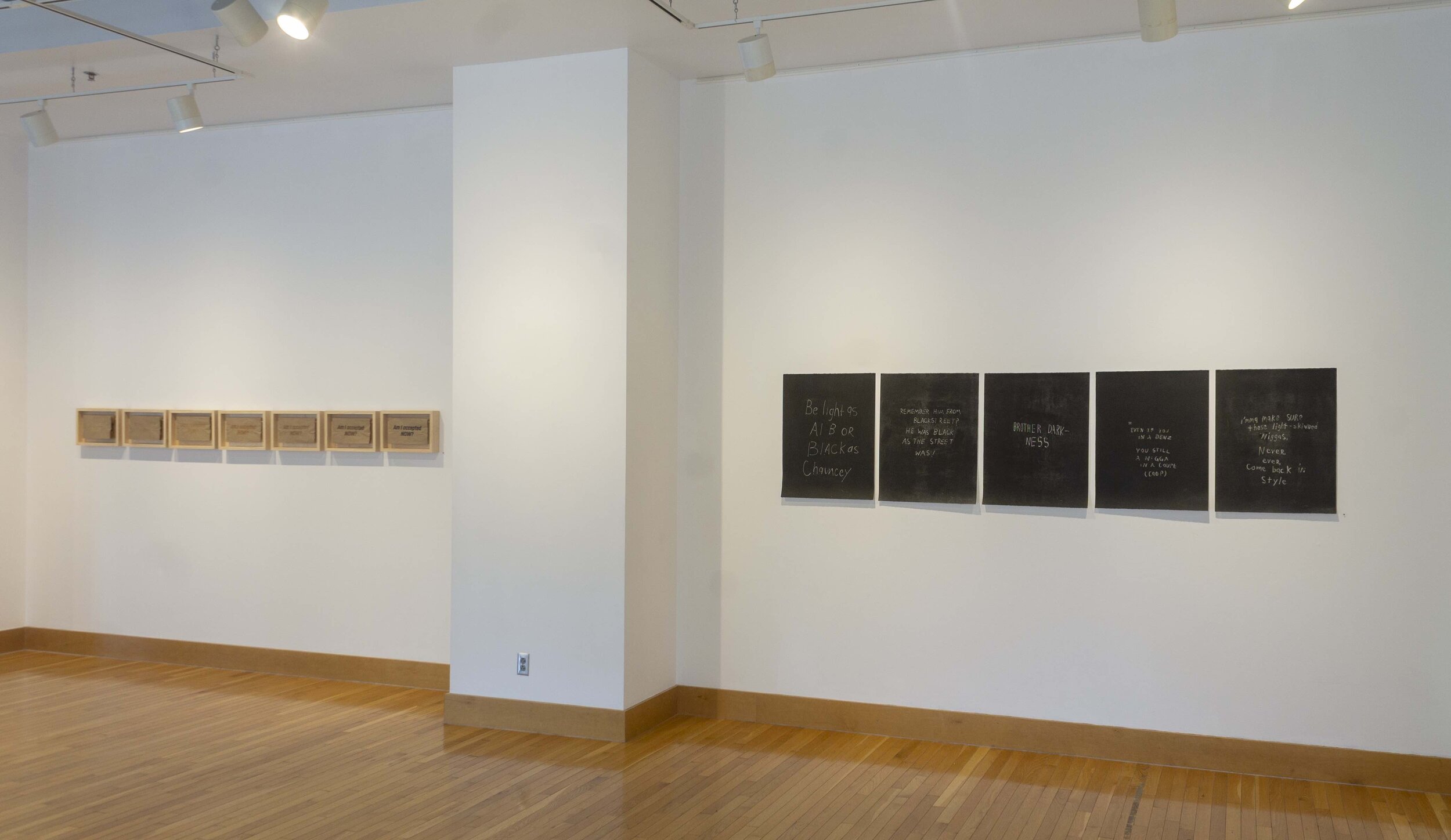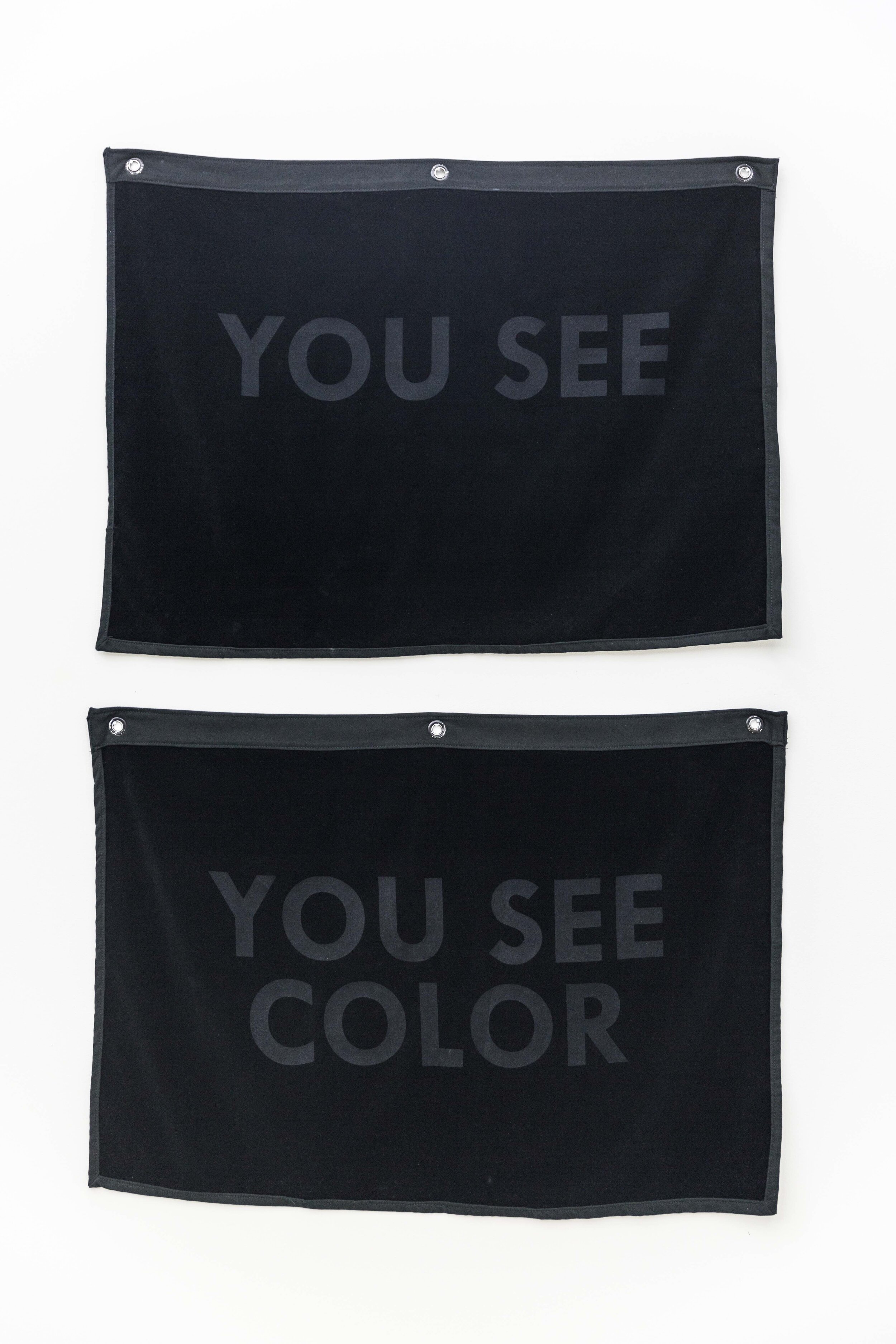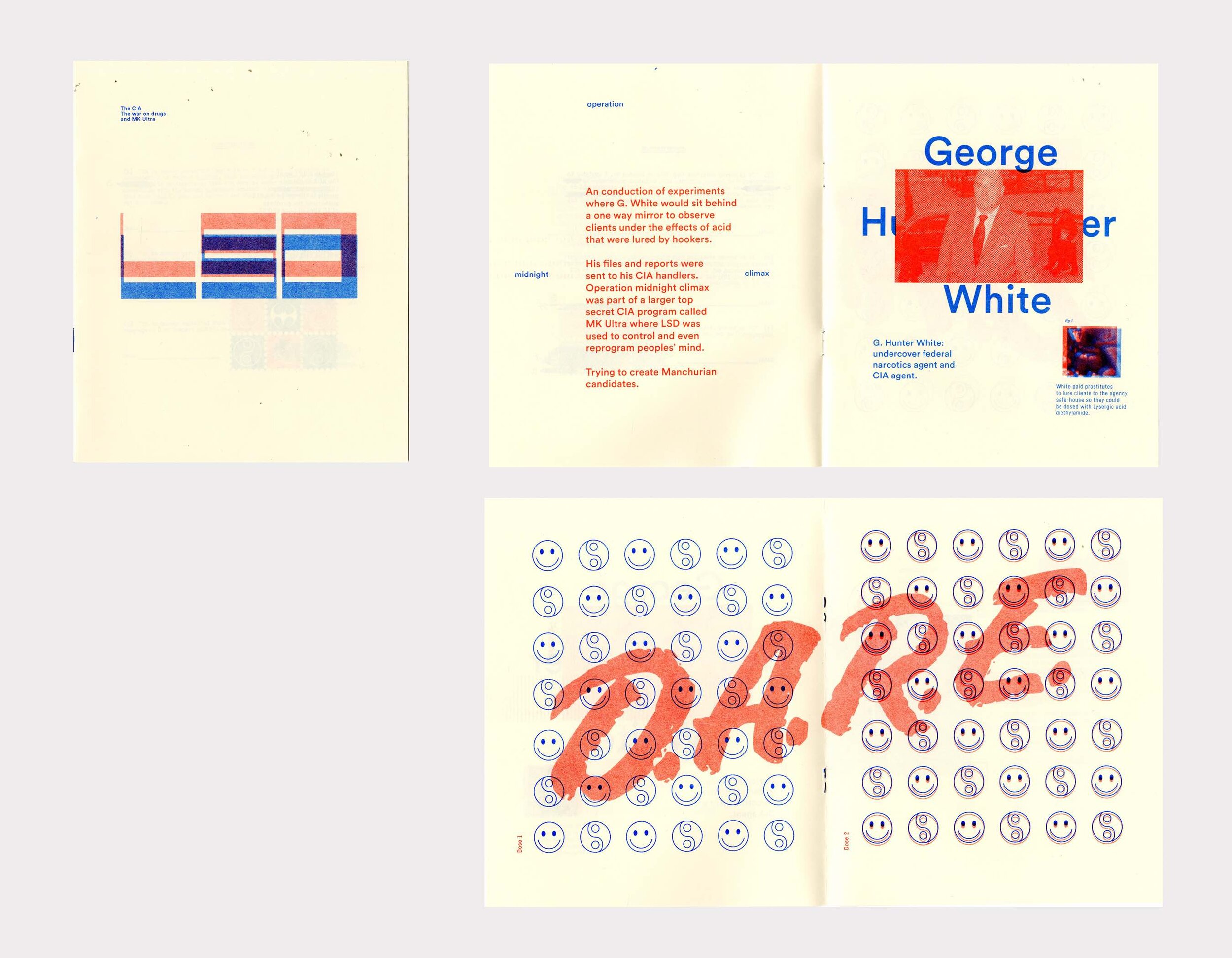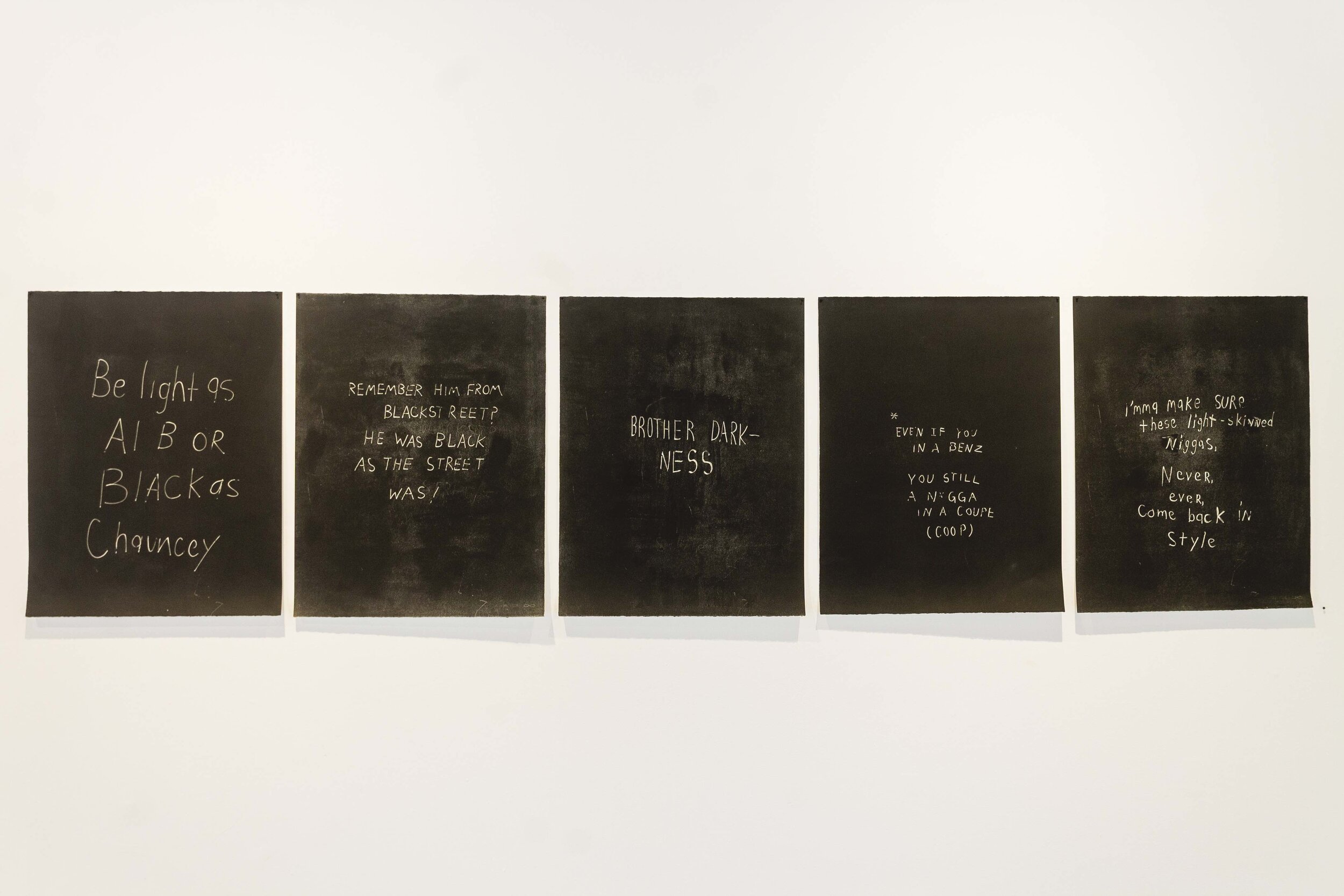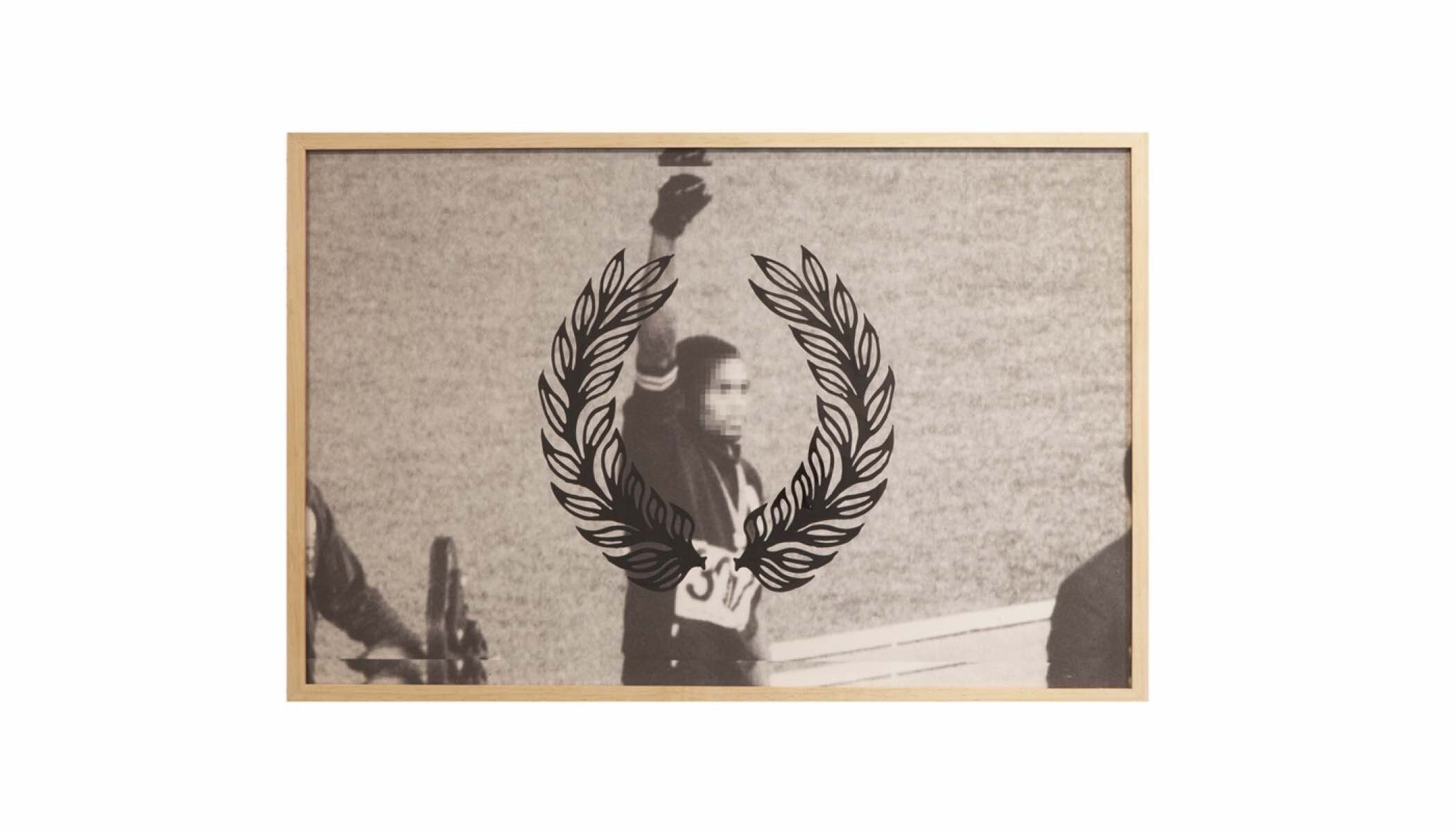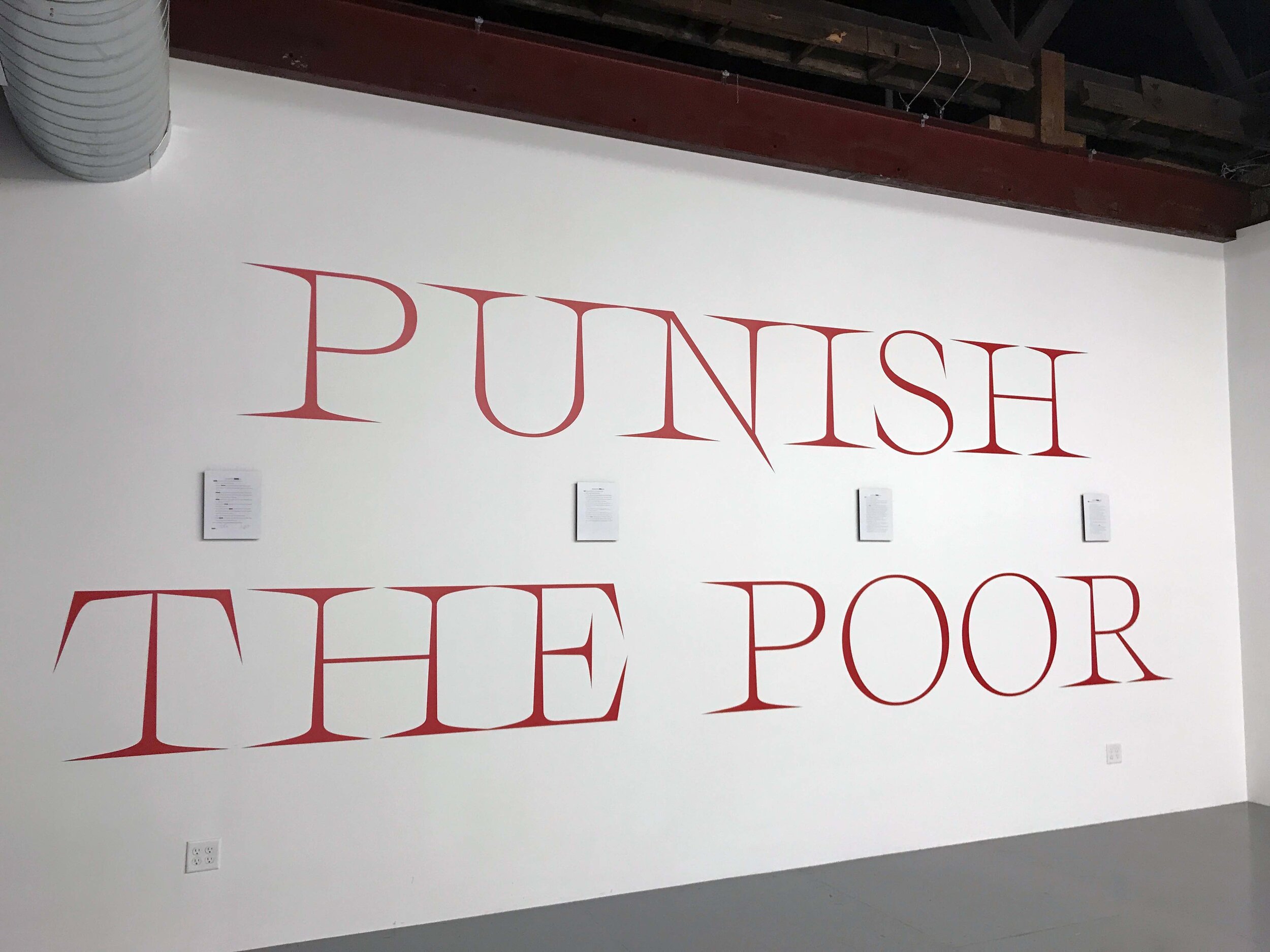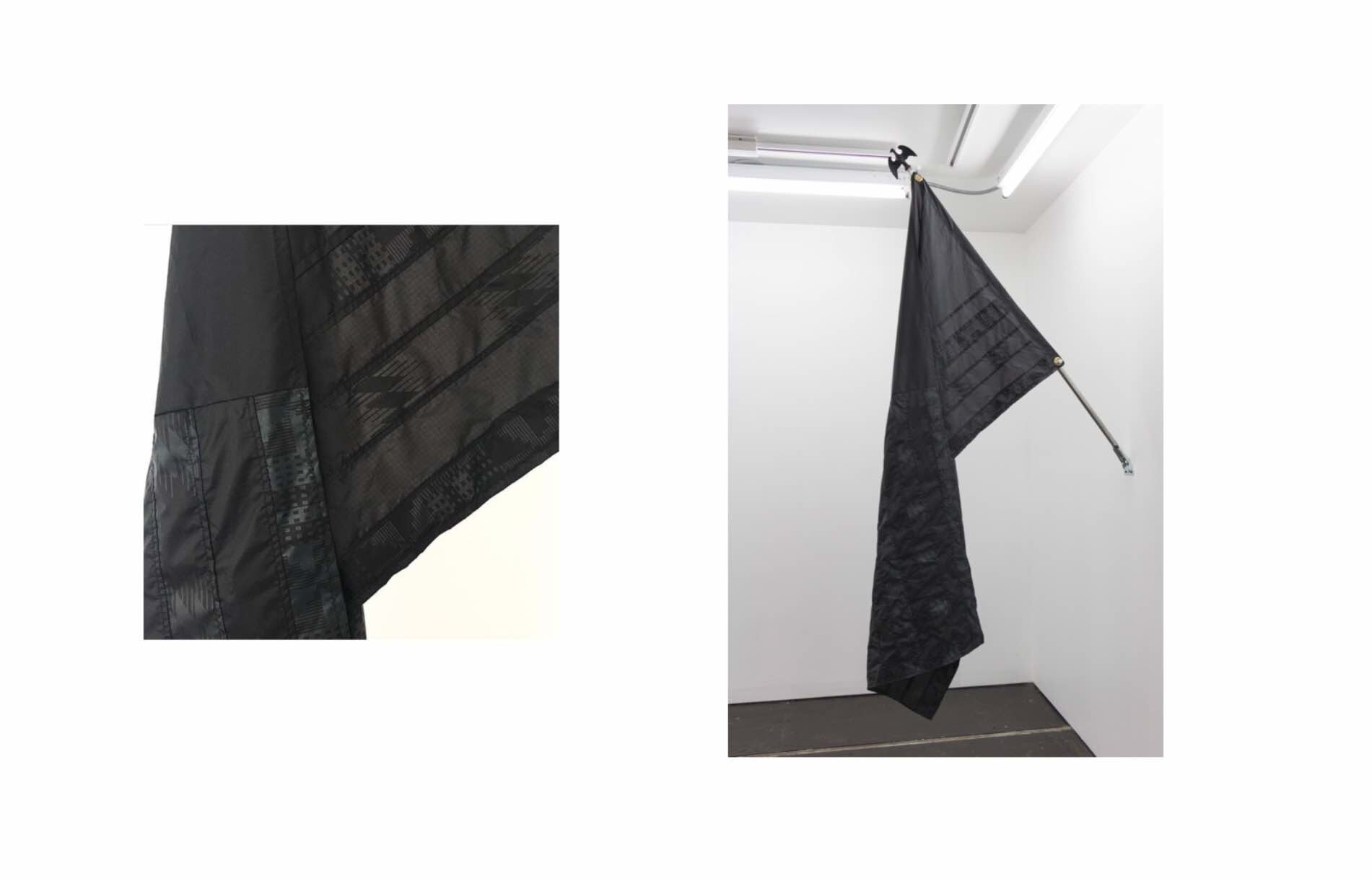Q&A: WORK/PLAY
By Jess T. Dugan | March 5, 2020
WORK/PLAY is an interdisciplinary design/art duo based in St. Louis, Missouri started by Danielle and Kevin McCoy. Kevin received a BFA in Graphic Communication from the University of Missouri-St. Louis and he recently graduated from the Sam Fox School of Design and Visual Arts, Washington University in St. Louis earning his MFA. Danielle is a conceptual artist, writer, and educator. Together, they integrate a hybrid of production methods such as design, printmaking, textile works, time-based media, exploratory writings, and the book arts to explore identity, racial inequality, erasure, and redacted histories.
The duo has exhibited both locally and nationally. Recent exhibitions include America's Mythic Time, The Luminary, St. Louis, MO; Small Talk at Crystal Bridges Museum of American Art, Bentonville, AR; SPF 1991 at projects+gallery, St. Louis, MO; Dream Wavers at Laband Gallery, Loyola Marymount University, Los Angeles, CA; Overview is a Place at SPRING/BREAK Art Show in New York, New York, NY; On & On at Beard and Weil Galleries in Norton, MA; Change of State at The Wassaic Projects in Wassaic, NY; Color-ism at Kranzberg Arts Center in St. Louis, MO. Recent book fairs include Printed Matter's LA Art Book Fair in Los Angeles, CA; Chicago Art Book Fair in Chicago, IL; Small Press Expo in St. Louis, MO; Fully Booked Art Fair in Dubai, UAE and Engaged Edition in New York, NY.
Jess T. Dugan: Hello Kevin and Danielle! Thanks so much for taking the time to speak with me. Before we jump into talking about your work, could you tell me a bit about each of yourselves? What initially led you to art-making, and what were you separate paths to getting to where you are today?
Danielle: I actually sat behind Kevin on the first day of class at UMSL. He was cute and funny and I instantly fell for him and his charm. I was on a clear path towards Biology and Pathology, but everything in my astrological sign always pointed towards creativity and the arts. I excelled from a young age, dabbling in ceramics, drawing, and writing, but never saw myself in that role. I come from a long line of business professionals, doctors, architects, and entrepreneurs, so the thought of being an artist never crossed my mind. I didn’t think it would fly with my family.
Kevin: My first love was graphic design. I was enamored with using type, hierarchy, layout, and imagery to communicate with a specific target audience. Although I never considered being an artist, I did learn how to draw at a very young age and I dabbled in oil painting for several years. I always viewed my expressive side (painting and drawing) as a meditative and cathartic process. Who knew that all of these disciplines would converge to become an integral cog in our practice!
JTD: You work as the collaborative duo WORK/PLAY, which you describe as an “interdisciplinary design duo combining illustration, minimal contemporary design, and experimental printmaking techniques.” You are also married, yes? Talk to me about your collaborative process. How did you come to work together? What do you each bring to the collaboration? What are some challenges and/or benefits of working together?
Danielle: We're going on 13 years of marriage and we’ve meticulously worked on building our art practice for more than half that time. From the beginning, I just followed Kevin into his passion. I would watch him paint in the most uncomfortable positions on his parent's kitchen floor because he didn't have a studio. I would lay across the bed and peek over his shoulder as he designed on his computer, and my love for the craft grew, but I was more interested in the business side: emails, arranging exhibitions, and assisting with concepts.
Kevin: Danielle would watch me work for hours!! I questioned why she didn’t find it boring but she enjoyed watching the decisions being made as I created. I think that part of the process was the common ground. Whether it was organizing an exhibition, producing collateral to promote the show or working through conceptually driven work, we enjoyed the decision-making process.
In actuality, Danielle HATED the name WORK/PLAY. I had to convince her as to why the name fits. It was so apropos! When we are working in the studio, we are having fun and playing around materially and conceptually. It does not feel like work. Conversely, when we are out “playing” by going to exhibitions, concerts, panels discussions or perhaps hanging out with friends, we are ever inspired by those experiences to make more work. Sometimes the lines are blurred and we can’t distinguish the two.
My design background spills over into the work, exhibition layout, and overall practice. I’ve learned that art and design have very similar objectives – they communicate.
With any duo, there are always debates. Sometimes we agree and there are times we have two different approaches to the same problem. We have learned the ebbs of flows of what spiritually feels right and to give right-of-way when one of us feels strongly to go in a particular direction.
JTD: What is your process like going from idea to final piece, particularly since you work in a wide variety of media?
Danielle: We talk about EVERYTHING. From the colors used, the process, the message we're conveying, the weight of paper, whatever – we discuss it and we get into an agreement. This sometimes means if one of us doesn't initially agree with the other, then we'll have to state our case and negotiate.
Kevin: There are times where we will plead our case but ultimately, the concept, the content, and space itself dictates not only the production methods but the materials as well. It really is an intuitive process. I’m not sure we can even take credit for the work. We tune out and let something much larger than the two of us take the wheel.
JTD: Much of your work centers around social and political issues, combining text and imagery to make powerful statements about issues such as racism and systemic injustice. Talk to me about the source of your work – where are you pulling from? What effect do you hope your works have on those who view them?
Danielle: 2014 changed everything. We sat in the sunroom of our apartment discussing life and the direction of our work when we heard a round of gunshots. That day marked the murder of VonDerrit Myers Jr. We questioned the work we had been making and our entire perspective shifted and our practice had a rebirth.
Kevin: A lot of our work is inspired by our own personal experiences and the traumatic experiences of black people we have read about. Sadly, it does not matter if you are wealthy, an athlete, well-educated or not. We understand that the same dark shadow of racism is cast over us no matter what. America has a catalog of brutality, racism, and systemic injustice. A good example would be our piece entitled Black Power from our series named When Stars Align, which was exhibited at projects+gallery in 2017. The work featured an image from the 1968 Olympics in Mexico where African-American athletes Tommie Smith and John Carlos hoisted the black fist in the air during the medal ceremony. The work is emblazoned with the words “BLACK-SKINNED STORM TROOPER'' which sits atop the image. This demonstration stimulated a myriad of death threats, public scorn, and it eventually cost them their gold medals. We felt led to do some sleuthing and we found out about a scathing article written by Brent Musberger about their demonstration. In the article, Musberger refers to the two athletes as “a couple of black-skinned storm troopers.” That article sent us in an entirely different direction for the work. We then opted to screen-print those words in roofing tar directly on top of the printed image. The duality of what tar represents symbolically led to this decision. First, tar baby was a racial epithet hurled at black people by racist whites. Second, tarring and feathering was considered the highest form of public critique. Combined, the duality of the words and material provides a multitude of layers in order to explore racism in America. In all honesty, there was no way to make that connection without being led intuitively to look in places where information is oftentimes redacted or missing altogether. Weeks after the opening, the director of the gallery excitedly explained that there was a whole podcast recently released discussing the 1968 Olympics brouhaha.
JTD: Talk to me about your publications – what role do these play in your larger practice? How do you feel that they exist within both the design and fine art realms?
Danielle: After creating together and exhibiting for so many years, we wanted the work to reach a broader audience (at an affordable price), so books felt like the most natural next step! We started locally with the St. Louis Small Press Expo, but I went into labor and we missed it – HAHA. We've since had our publications included in the Chicago Art Book Fair, LA Art Book Fair, Fully Booked, and Booklyn to name a few.
Kevin: I consider artist books works of art themselves, whether they employ impactful design using visual content or a mix of literary works coupled with imagery. Books can be solitary or group experiences, but the accessibility and tactile nature of the books makes for an exciting experience and a fun medium to work with. We understand that not everyone will make it to a gallery to see works. Some people don’t feel welcomed in these spaces. The book is a unique way to connect with people in their safe space in order to explore topics and experiences that we are greatly affected and inspired by. It is secretly our rebellious way of pushing back against a seemingly digitized world. Information comes so quickly to us on our phones, tablets, computers, etc. By the time a few people find out, it is already old news and quickly swept under the rug. I feel that books, however, leave a residue. They’re tangible objects that one can physically move through. We can control or manipulate that experience by adjusting the color, image, sequence, formatting, paper texture, materials, print processes, and even the smell.
JTD: You and I met because we live in St. Louis, a city that I feel is often overlooked (along with the majority of the middle of the country) by the larger national/coastal art scene. However, since I’ve been here, I’ve been struck by the vibrancy of the art scene as well as the viability St. Louis provides to an art career. Because it is an affordable city, it’s much easier to come by space and time, which are both so necessary for a creative practice. And, of course, there are all kinds of social and political issues at play here, many of which have been on the national radar over the past few years. What are your thoughts about living and working as artists in St. Louis? To what extent do you feel like your work is informed by your experiences in St. Louis?
Danielle: A lot of our inspiration comes from our surroundings here in St. Louis and the political climate that we and many Black Americans experience in this country. We also draw inspiration from traveling and the conversations we have with others. These conversations, particularly, have sparked a few books we’ve produced. Language is so, so important. Along with owning your voice and your language, we have to own our words. This is why I'm so interested in the art of storytelling. Allowing others to use their voices to grace the pages of a publication so that their story, in some shape, can be told and shared with others of like-mind.
Kevin: St. Louis forces you to work hard. Period. Back in the 90s, I can clearly recall the cardinal-colored license plates that read “Show Me State.” I never forgot that unofficial slogan but it is now my personal mantra. I feel like we are overlooked because we are in the Midwest so we do our best to make our presence known and help shed light on the vibrant creative community that resides here.
As far as local experiences are concerned, we can bear witness to the political and systemic issues at play here on a micro-scale. Having gained that knowledge, we are able to distill and think critically about those same issues on a much broader scale and the other movable parts associated therein. For example, the term “workhouse” dates back to a city ordinance from 1843 where a detainee would have to work off a fine before being released. So essentially the workhouse is a debtor’s prison, but this is not solely a product of the United States. Debtor’s prisons were actually common in Western Europe. This is proof that these issues are interconnected with other parts of the globe well beyond our locale.
JTD: What projects are you currently working on, and what’s on the horizon for you both?
Danielle: I'm currently taking my time writing a book of poetry and a near-future story about love. Each of these won’t be ready for a few years, so I have a lot of work to do. There are also a few other collaborative projects in the works, one with Candor Books in Chicago, so some fun projects are on the way!
Kevin: We just completed newly commissioned work for the group exhibition titled America’s Mythic Time, curated by Katherine Simóne Reynolds and presented by civil rights law firm ArchCity Defenders and The Luminary. The exhibition features works from an amazing roster of artists to explore the mass incarceration of poor communities of color.
As for newer shit, I’m personally itching to do another billboard! Any takers?
All images © WORK/PLAY




